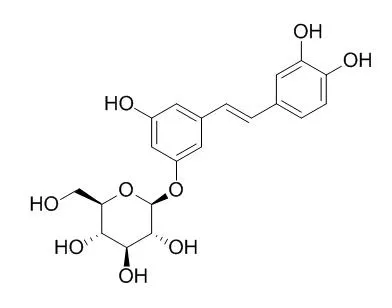| In vivo: |
| Chinese Journal of Physiology, 2011, 54(3):183-9. | | Astringinin-mediated attenuation of the hepatic injury following trauma-hemorrhage.[Pubmed: 21789900] | Although Astringinin administration under adverse circulatory conditions is known to be protective, the mechanism by which Astringinin produces the salutary effects remains unknown.
METHODS AND RESULTS:
Different doses of Astringinin (0.01, 0.03, 0.1, 0.3 mg/kg of body weight) or vehicle were administered intravenously during resuscitation. Concentrations of plasma aspartate aminotransferase (AST) with alanine aminotransferase (ALT) and various hepatic parameters were measured (n = 8 rats/group) at 24 h after resuscitation. One-way ANOVA and Tukey testing were used for statistical analysis. Trauma-hemorrhage significantly increased plasma AST and ALT levels at 24 h postresuscitation; there was a dose-related benefit when Astringinin was administered at doses of 0.01 to 0.3 mg/kg. In Astringinin-treated (0.3 mg/kg) rats subjected to trauma-hemorrhage, there were significant improvements in liver myeloperoxidase (MPO) activity (237.80 +/- 45.89 vs. 495.95 +/- 70.64 U/mg protein, P < 0.05), interleukin-6 (IL-6) levels (218.54 +/- 34.52 vs. 478.60 +/- 76.21 pg/mg protein, P < 0.05), cytokine-induced neutrophil chemoattractant (CINC)-1 (88.32 +/- 20.33 vs. 200.70 +/- 32.68 pg/mg protein, P < 0.05), CINC-3 (110.83 +/- 26.63 vs. 290.14 +/- 76.82 pg/mg protein, P < 0.05) and intercellular adhesion molecule (ICAM)-1 concentrations (1,868.5 +/- 211.5 vs. 3,645.0 +/- 709.2 pg/mg protein, P < 0.05), as well as in histology. Results show that Astringinin significantly attenuates proinflammatory responses and hepatic injury after trauma-hemorrhage.
CONCLUSIONS:
In conclusion, the salutary effects of Astringinin administration on attenuation of hepatic injury following trauma-hemorrhage are likely due to reduction of pro-inflammatory mediator levels. |
|






 Cell. 2018 Jan 11;172(1-2):249-261.e12. doi: 10.1016/j.cell.2017.12.019.IF=36.216(2019)
Cell. 2018 Jan 11;172(1-2):249-261.e12. doi: 10.1016/j.cell.2017.12.019.IF=36.216(2019) Cell Metab. 2020 Mar 3;31(3):534-548.e5. doi: 10.1016/j.cmet.2020.01.002.IF=22.415(2019)
Cell Metab. 2020 Mar 3;31(3):534-548.e5. doi: 10.1016/j.cmet.2020.01.002.IF=22.415(2019) Mol Cell. 2017 Nov 16;68(4):673-685.e6. doi: 10.1016/j.molcel.2017.10.022.IF=14.548(2019)
Mol Cell. 2017 Nov 16;68(4):673-685.e6. doi: 10.1016/j.molcel.2017.10.022.IF=14.548(2019)